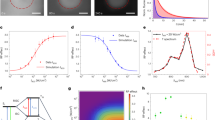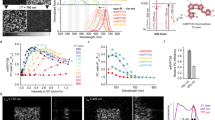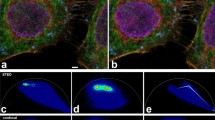Abstract
Noninvasive, straightforward methods to inactivate selected proteins in living cells with high spatiotemporal resolution are needed. Chromophore-assisted laser inactivation (CALI) can be used to photochemically inactivate proteins, but it has several drawbacks, such as procedural complexity and nonspecific photodamage. Here we show that by application of multiphoton excitation to CALI, enhanced green fluorescent protein (EGFP) is an effective chromophore for inactivation of a protein's function without nonspecific photodamage in living mammalian cells.
This is a preview of subscription content, access via your institution
Access options
Subscribe to this journal
Receive 12 print issues and online access
$259.00 per year
only $21.58 per issue
Buy this article
- Purchase on Springer Link
- Instant access to full article PDF
Prices may be subject to local taxes which are calculated during checkout


Similar content being viewed by others
References
Jay, D.G. Proc. Natl. Acad. Sci. USA 85, 5454–5458 (1988).
Liao, J.C., Roider, J. & Jay, D.G. Proc. Natl. Acad. Sci. USA 91, 2659–2663 (1994).
Rajfur, Z., Roy, P., Otey, C., Romer, L. & Jacobson, K. Nat. Cell Biol. 4, 286–293 (2002).
Tour, O., Meijer, R.M., Zacharias, D.A., Adams, S.R. & Tsien, R.Y. Nat. Biotechnol. 21, 1505–1508 (2003).
Surrey, T. et al. Proc. Natl. Acad. Sci. USA 95, 4293–4298 (1998).
Stroffekova, K., Proenza, C. & Beam, K.G. Pflugers Arch. 442, 859–866 (2001).
Denk, W., Strickler, J.H. & Webb, W.W. Science 248, 73–76 (1990).
Zipfel, W.R., Williams, R.M. & Webb, W.W. Nat. Biotechnol. 21, 1369–1377 (2003).
Oyamada, Y., Zhou, W., Oyamada, H., Takamatsu, T. & Oyamada, M. Exp. Cell Res. 273, 85–94 (2002).
Contreras, J.E., Saez, J.C., Bukauskas, F.F. & Bennett, M.V. Proc. Natl. Acad. Sci. USA 100, 11388–11393 (2003).
Valiunas, V., Bukauskas, F.F. & Weingart, R. Circ. Res. 80, 708–719 (1997).
Campbell, R.E. et al. Proc. Natl. Acad. Sci. USA 99, 7877–7882 (2002).
Schonle, A. & Hell, S. Opt. Lett. 23, 325–327 (1998).
Murata-Hori, M., Tatsuka, M. & Wang, Y.L. Mol. Biol. Cell 13, 1099–1108 (2002).
Murata-Hori, M. & Wang, Y.L. Curr. Biol. 12, 894–899 (2002).
Acknowledgements
This work was supported by funds for Core Research for Evolutional Science and Technology (CREST) of the Japan Science and Technology Corporation (JST) and by grants-in-aid for scientific research from the Ministry of Education, Culture, Sports, Science and Technology, Japan. We wish to thank R.Y. Tsien (University of California at San Diego) for providing the gene encoding mRFP1, Y.L. Wang (University of Massachusetts Medical School) for providing the gene encoding aurora B-EGFP, and R. Weingart (University of Bern, Switzerland) for helpful suggestions, discussions and critical review of this manuscript.
Author information
Authors and Affiliations
Corresponding author
Ethics declarations
Competing interests
The authors declare no competing financial interests.
Supplementary information
Supplementary Fig. 1
MP-CALI does not influence the integrity of the plasma membrane. (PDF 3820 kb)
Supplementary Fig. 2
Recovery of Cx43-EGFP signals after MP-CALI. (PDF 2914 kb)
Supplementary Fig. 3
Proteins in the proximity of the EGFP fusion proteins undergoing MP-CALI are not destroyed via bystander effect. (PDF 96 kb)
Rights and permissions
About this article
Cite this article
Tanabe, T., Oyamada, M., Fujita, K. et al. Multiphoton excitation–evoked chromophore-assisted laser inactivation using green fluorescent protein. Nat Methods 2, 503–505 (2005). https://doi.org/10.1038/nmeth770
Received:
Accepted:
Published:
Issue Date:
DOI: https://doi.org/10.1038/nmeth770
This article is cited by
-
Transient photothermal inactivation of Escherichia coli stained with visible dyes by using a nanosecond pulsed laser
Scientific Reports (2020)
-
Targeted two-photon chemical apoptotic ablation of defined cell types in vivo
Nature Communications (2017)
-
Connexin43 Functions as a Novel Interacting Partner of Heat Shock Cognate Protein 70
Scientific Reports (2013)
-
Polymer-drug conjugates for intracellar molecule-targeted photoinduced inactivation of protein and growth inhibition of cancer cells
Scientific Reports (2012)
-
Chromophore-assisted laser inactivation in neural development
Neuroscience Bulletin (2012)



